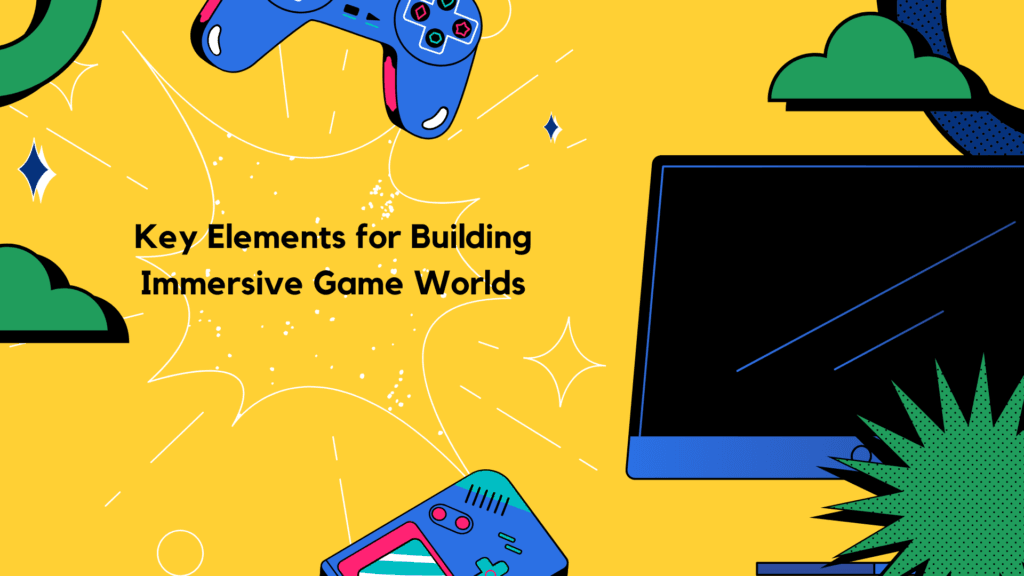Building Immersive Game Worlds: A Guide to Deep Lore, Interactivity, and Realism
Table of Contents
Introduction to Immersive Game World-Building
Creating an immersive game world is an intricate art that blends design, storytelling, and interactivity into a cohesive experience. When players enter a game, they seek a world that feels real and inviting, where they can lose themselves in the environment, stories, and characters. This guide aims to help intermediate developers elevate their world-building techniques, crafting worlds that are not only visually stunning but also rich in lore, interactive, and emotionally engaging.
What Makes Game Worlds Immersive?
To create an immersive game world, developers must focus on believability and player engagement. Players are drawn to worlds that feel both vast and cohesive. They want an experience where their choices matter, where environments are dynamic, and where the depth of the world feels limitless. This is achieved through a careful mix of interactivity, story depth, and visual storytelling. The goal is to make players feel as if they’re not just playing a game but participating in a living, breathing world.
Importance of Believability and Player Engagement
Believability goes beyond realistic graphics; it encompasses the world’s logic, culture, and history. When players find coherence in the lore and consistency in the setting, they invest emotionally, forming a connection with the world and its inhabitants. Engagement, on the other hand, is what keeps players interested and invested. When they encounter detailed stories, evolving environments, and responsive NPCs (Non-Player Characters), players feel an active role in shaping the world.
Who Is This Guide For?
This guide is crafted for intermediate developers who already have foundational skills in game design and storytelling and are now looking to deepen their world-building abilities. From creating nuanced lore to developing interactive settings, this guide provides actionable insights to make game worlds captivating and immersive.
Key Elements for Building Immersive Game Worlds

Crafting Rich and Consistent Lore
Lore is the backbone of any immersive game world. Rich lore allows players to explore a place filled with history, myth, and culture, adding layers to the experience.
- Develop a Cohesive Backstory: Every world needs a well-thought-out backstory that informs its current state, affecting everything from politics to regional conflicts.
- Draw from Mythology, History, and Culture: Inspired by real-world sources, create unique traditions, belief systems, and historical events that deepen players’ understanding of the game world.
- Ensure Consistency: Keep lore consistent across characters, settings, and storylines. Minor inconsistencies can break immersion, so document all details of the world carefully.
Creating a Sense of Scale and Geography
A believable game world requires realistic landscapes and a sense of scale that makes it feel expansive and rich in variety.
- Varied Landscapes and Topographies: Design diverse biomes, from snowy mountains to sprawling deserts, giving players a sense of movement across different regions.
- Realistic Ecosystems and Animal Behavior: Populate the world with flora and fauna that respond to environmental changes, adding to the realism.
- Travel Times and Distances: Incorporate realistic travel elements—whether by horse, ship, or foot—to convey vast distances and create the feeling of a grand, interconnected world.
Designing Interactive and Dynamic Environments
Interactivity is at the heart of player engagement. Players should feel encouraged to explore and experiment within the world, rewarded for their curiosity.
- Encourage Exploration: Place hidden paths, puzzles, and collectibles in the game world. Let players feel like every corner holds potential discoveries.
- Reactive Environments: Enable the environment to react to player actions, such as NPCs altering behavior, weather shifts, or time-of-day changes.
- Dynamic Audio and Visual Effects: Introduce subtle changes in sound and visuals in response to player presence, like the crackling of leaves underfoot or an ambient music shift when danger is near.
Embedding Small Details and Environmental Storytelling
Environmental storytelling is a powerful tool that reveals the game world’s history and culture without explicit exposition.
- Include Small, Meaningful Details: Items like worn books, faded graffiti, or ancient relics serve as visual cues that suggest a world with history.
- Reveal Past Events with Environmental Cues: Ruins, abandoned structures, or forgotten battlefields offer a glimpse into past events, letting players piece together history.
- Use Non-Verbal Storytelling: Position objects, textures, and settings in ways that hint at character backstories or previous conflicts, inviting players to engage with the world’s lore intuitively.
Advanced Techniques for Integrating Story and Environment

Merging Story with Setting
When environments reflect the story, players can connect more deeply with the world and the narrative.
- Create Story-Rich Settings: For instance, design a haunted mansion that represents the antagonist’s troubled past, with worn furniture and eerie shadows telling parts of the story.
- Use Story Props: Subtly include objects related to the story, such as a hero’s abandoned armor or an ancient weapon, to reinforce the game’s backstory.
- Tie Character Backstories to Locations: Specific locations, like childhood homes or ancestral battlefields, can create emotional resonance and further immersion.
Designing NPCs and Cultures to Reflect World Lore
NPCs are windows into the culture and history of a game world. When NPCs have unique dialects, customs, and stories, they bring the world to life.
- Give NPCs Distinctive Traits: Dialects, attire, and customs rooted in the game world’s lore make each NPC unique and believable.
- Organic Lore Discovery: Allow players to learn about the world through NPC dialogues, overheard conversations, or local stories, revealing lore naturally.
- Cultural Symbols and Architecture: Use architectural styles, attire, and symbols to differentiate regions, giving players a sense of traveling through diverse societies.
Implementing Visual and Audio Cues for Storytelling
Visual and audio cues significantly affect how players perceive a world, evoking emotions and setting the tone.
- Atmospheric Music and Sound Effects: Background music and sound effects (like distant thunder or market chatter) create atmosphere and immersion.
- Lighting and Visual Effects: Use lighting shifts, fog, or mist to create mood or tension, particularly in key storytelling moments.
- Event-Based Sound Design: Sounds that respond to player actions, like a sudden hush in the forest, add tension and depth.
Best Practices for Believable World-Building
Consistency Is Key
Consistency in all elements—whether lore, geography, or character traits—maintains immersion.
- Document Details: Track information on lore, character backgrounds, and settings to ensure no contradictions arise.
- Align Elements with Story Tone: From architecture to NPC mannerisms, all aspects should fit within the established lore and story tone.
Incorporate Player Feedback and Testing
Playtesting allows developers to identify and fix areas where immersion may break.
- Extensive Playtesting: Observe how players interact with the world and where they encounter confusion or loss of immersion.
- Adjust Based on Feedback: If players report issues with specific mechanics or world elements, adjust to enhance seamless engagement.
Make the World Feel Lived-In
A world that feels lived-in draws players deeper into its history and culture.
- Signs of Wear and History: Buildings, roads, and objects with signs of wear make the world feel aged and real.
- Daily Life Elements: Add elements like cooking fires, children’s toys, and NPC routines to give the sense of an active, bustling world.
Bringing It All Together
Crafting an immersive game world requires an understanding that goes beyond visuals alone. It involves a blend of lore, interactive environments, and a player-centric design approach to keep players engaged. Each detail, from the smallest environmental cue to the larger world-building elements, contributes to an experience that feels as vast and complex as reality.
Do’s and Don’ts
- Do: Keep lore consistent, use dynamic elements, add environmental storytelling, and ensure the world feels lived-in.
- Don’t: Overlook small details, ignore player feedback, or let inconsistencies creep into world lore.
FAQs
1. How can I ensure my world-building is consistent? Document all details and keep a reference guide to maintain consistency in lore, geography, and characters.
2. How can environmental storytelling enhance player immersion? Environmental storytelling allows players to discover the world’s backstory organically, enhancing engagement without relying solely on exposition.
3. What makes an NPC believable? NPCs feel real when they have unique personalities, dialects, and routines that align with the world’s lore and culture.
Tips
- Use player feedback to refine immersion elements.
- Incorporate varied landscapes to create scale.
- Allow story to evolve based on player actions.
- Integrate culture and history into NPC dialogue.
- Use lighting and sound to set emotional tones.
Story time :
Once upon a time, in the kingdom of Velexia, a young game developer named Aiden was on a quest to create the most immersive game world ever known. Aiden had always been inspired by the stories and landscapes of the fantasy worlds he grew up exploring in games, and he wanted to create a world where players could truly feel lost in the magic, as though they were living it themselves. But how?
Aiden decided to start by building the history of his game’s world, which he named Eldraen. He imagined a vast land once ruled by ancient beings called the Aelari, a mysterious race who had vanished, leaving only ruins and relics behind. He crafted stories of wars and alliances, myths of magic-bearing crystals, and tales of lost kingdoms hidden deep within Eldraen’s forests and mountains.
As he developed the world, he made sure everything felt consistent and true to the lore. Each village had its own customs, each character their unique past shaped by this history. Aiden realized that, to make Eldraen believable, every detail mattered. If a city was once struck by a devastating war, he’d leave remnants of destroyed buildings and armor, pieces of the past that players could discover, each piece adding to the world’s story.
Aiden wanted Eldraen to feel expansive, so he designed vast landscapes with diverse regions. Some areas had icy peaks; others, lush forests or barren deserts. He thought about how players would travel across the land, adding in realistic travel times and features like trade routes and hidden paths. He knew that players would feel the world was large only if it looked and behaved in a way that was grounded in reality.
Then came the idea of making Eldraen interactive and dynamic. Aiden added elements players could interact with: enchanted forests with puzzles, ruins hiding relics, and NPCs who responded to actions. A knight who would remember if you helped him, or a merchant who would raise prices if you mistreated his people. The world responded, making players feel like they had a real impact.
Aiden understood that small details were essential. He scattered broken shields and ancient runes around battlefields, leaving hints about the world’s history for players who paid attention. He added echoes in caves, flickering torches in dark halls, and weather that shifted with the seasons. Every element told a story, immersing players deeper into Eldraen.
Finally, Aiden knew he needed to tie it all together with sound and visuals. He created haunting music for the ancient ruins, lively tunes for village markets, and distant bird calls and wind rustling through trees. He used light and shadows to change the mood, like a mist that crept over a cursed forest at dawn.
When the game was ready, Aiden invited players to experience Eldraen. They didn’t just play; they explored. They noticed the details, felt the history, and became a part of the world. Eldraen was more than a game—it was a story, a journey. And through his attention to detail and love for storytelling, Aiden had crafted a world players would remember long after they’d left.
Want to Get Hosting ? Click here for 20% off on 1 year hosting and Free Domain name
















Pingback: Mastering Game Sound Design: Illegendaries.in
vorbelutr ioperbir
I got what you mean ,saved to my bookmarks, very decent internet site.